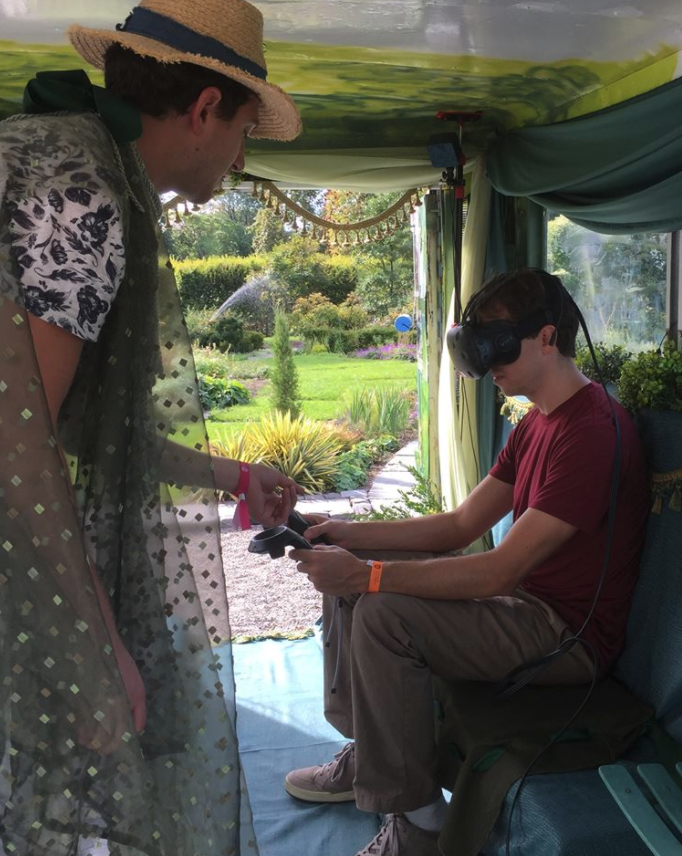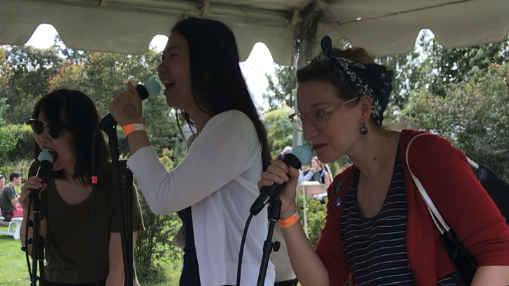Kellian recently contributed to a No Proscenium article “On Accessibility and the Demand for Immersive Experiences (Future of Storytelling Festival Recap)” along with Kathryn Yu and Leah Ableson. Below, we’ve included Kellian’s contribution and hope you’ll click the link above to read the rest!!
In a small way, FoST may have showed us what we want the future of storytelling to be and what in reality, it actually might be.
We had to drive up from Boston, so we made it as early as we could on Saturday morning, around 10:00am. Everything we wanted to see was already unavailable. Broken Bone Bathtub had been cancelled, Ghost Courtand the Smellwalk were full, and there was absolutely no chance at all of getting into the two Alice interactives or Flock.
When I asked organizers what was happening, the response was something like a weary scoff — and this was at 10:00am on Saturday. Clearly they’d had this conversation many, many times before.
What was available was VR, and lots of it. VR rigs everywhere. I personally am not a huge fan of VR. But one thing I had to admit was that VR had throughput, and it was functional. Every booth had a chair with a bunch of VR rigs ready for me to play. This might just be a matter of VR being an older technology than mixed reality, so there are lots of Gear VR and Oculus headsets available at reasonable prices. Maybe that wouldn’t have been the case in 2014. Or… it may tell us more about why media companies keep building for and betting on VR even when everybody I know says they find it isolating.

Virtual Reality has a creation, sales, and distribution model that companies know and recognize. They build media. You can only view this media on one type of hardware, which consumer can purchase. This is an old story: television, radio, Xbox, iPhones. Buy the hardware to get access to the content. There’s an existing, well-understood model for both churning out content and ensuring its distribution.
People raved about Holojam in Wonderland and I heard from so many people that Flock was wonderful, but these mixed reality pieces couldn’t scale, so I never saw them. Why are we surprised that so many people want to see creative, beautiful stories? We should be ready for this. Even if they had expected 5,000 rather than 3,000 people, what would Flock have done? How could Holojam have scaled to fit more people in? The fact is, live- and mixed-reality immersive isn’t really prepared for the numbers we’re going to get if we want to survive; meanwhile VR is locked, loaded, and ready to meet demand.
The situation reminded me of reality TV. It’s cheap to make. It’s reliable as an endless source of content. A TV producer might be able to attract only 70% of their potential audience and still make more money than if they had paid for a high production value show with writers and actors and directors. In the end, a much lower quality product can be a better bet for companies and end up being the new entertainment model that gets adopted. If we’re considering the future of storytelling, I think we need to think about this stuff.
There were a few programs that seemed ready to deal with scaling issues. OurSpace was a fun, goofy, immersive experience that ran off of WhatsApp. They could have run that game all day with 100 people or more for each run. Improv Everywhere also had a system that could scale: you downloaded an app and you all played the story together. It also could have been run multiple times for larger numbers of people if they’d wanted to do that. These are mixed reality immersive experiences that used existing technology, which is a great way to scale an experience: let some other massive company deal with scale. You just write stories for it.

Emilie Baltz’s POPSTARS also had an interesting setup. This was a musical lollipop that the artist attached to a microphone so when you licked it, it made sounds in response. It’s what I like to call the “Yelp” model: a few active participants and a large number of casual watchers. Only three people could play at a time, but the rest of the audience had fun watching the craziness unfold. It was a quick turnover — maybe three minutes per lollipop group. Audience members could watch for a few minutes, move on, and still have a great experience to talk about.
I’m not saying that all immersive theatre and mixed reality works need use existing technology or depend on goofy interactions for success. But if we’re going to truly be part of the “future of storytelling” we need to think about audience throughput and scale now. Escape rooms and the entire haunt industry are immersive entertainment models that have found scaleable solutions. I don’t think the lines and the sell-outs were necessarily a festival problem; I think we’re going to see a lot of this as immersive grows.
If organizers and creators can’t scale reliably, these experiences are going to be like the quaint a capella singers that wandered throughout the festival grounds all weekend: a novelty, but not exactly the future of storytelling.


Leave a Reply